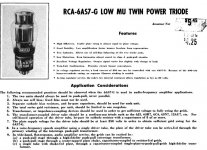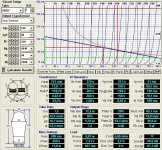Number 2 is true for any high transconductance tube; if supply voltages drift at all, the current will change enormously, potentially destroying the tube.
Strange. Given that the 6AS7G is a series pass regulator valve (where it was common to connect many units in parallel), I can't see any reason for the first stricture. I's be most interested to hear if anyone does have a reasonable explanation.
As for the second, they're owning up to the fact that the valve passes considerable grid current and that variations between units are large.
I'm not sure I would place too much credence in the words on that data sheet (even though it's RCA). The "features" are being bent to apply to a valve designed for one specific service yet being promoted for something completely different. There's a whiff of non-engineering marketing...
As for the second, they're owning up to the fact that the valve passes considerable grid current and that variations between units are large.
I'm not sure I would place too much credence in the words on that data sheet (even though it's RCA). The "features" are being bent to apply to a valve designed for one specific service yet being promoted for something completely different. There's a whiff of non-engineering marketing...
All these regulator tubes with two section require a means of equalizing the current between the two parts in case of parallel connection, like the modern transistor.
Otherwise one section will overdissipate.
This is done in case of 6as7/6080 by a small cathode resistor on each cathode.
In some other datasheet (http://www.mif.pg.gda.pl/homepages/frank/sheets/009/6/6080.pdf, note 1) is reported the min 15V drop to assure stability.
Otherwise one section will overdissipate.
This is done in case of 6as7/6080 by a small cathode resistor on each cathode.
In some other datasheet (http://www.mif.pg.gda.pl/homepages/frank/sheets/009/6/6080.pdf, note 1) is reported the min 15V drop to assure stability.
Question (or statement)
In the well known OTL from Rozenblitz 6AS7's are used in parallel with fixed bias. This is a push pull design, so one triode can go to the top and other to the bottom (you won't parallel both triodes, as recommended in point 1) - but using 4 'botlles' (or even more) paralleled implies in paralleled triodes anyway (but from different bottles). As all triodes will be supplied from the same B+ and from the same bias (which is not regulated in this OTL) their conduction should be the same (is this true??)
But then, fixed bias is not recommended for this tube, and for me (as a noob) self bias seems very difficult to apply in an OTL, if not impossible.
In this tube, with most of the times very mismatched halves, self bias would not work that well (difference in current through each triode would cause saturation of the OPT). In the 'maurits' amplifier (6AS7 in PP at the output) self bias is used, but they use a potentiometer to regulate individual bias less or more. A good solution seems something like this kit http://www.machmat.com/sales/kits/afb.htm (I am not affiliated with him, I just saw that this was mentioned in another thread and found it a very interesting idea). Now I am thinking of a way to apply AFB to regulate the bias from 6AS7 triodes in an OTL - because fixed bias doesn't seem that good for the 6AS7, as you can read in the application note from RCA 😀
Well, this post is messy, containing, 'affirmations', ideas and questions. But maybe it helps for the sake of discussion!
Erik
In the well known OTL from Rozenblitz 6AS7's are used in parallel with fixed bias. This is a push pull design, so one triode can go to the top and other to the bottom (you won't parallel both triodes, as recommended in point 1) - but using 4 'botlles' (or even more) paralleled implies in paralleled triodes anyway (but from different bottles). As all triodes will be supplied from the same B+ and from the same bias (which is not regulated in this OTL) their conduction should be the same (is this true??)
But then, fixed bias is not recommended for this tube, and for me (as a noob) self bias seems very difficult to apply in an OTL, if not impossible.
In this tube, with most of the times very mismatched halves, self bias would not work that well (difference in current through each triode would cause saturation of the OPT). In the 'maurits' amplifier (6AS7 in PP at the output) self bias is used, but they use a potentiometer to regulate individual bias less or more. A good solution seems something like this kit http://www.machmat.com/sales/kits/afb.htm (I am not affiliated with him, I just saw that this was mentioned in another thread and found it a very interesting idea). Now I am thinking of a way to apply AFB to regulate the bias from 6AS7 triodes in an OTL - because fixed bias doesn't seem that good for the 6AS7, as you can read in the application note from RCA 😀
Well, this post is messy, containing, 'affirmations', ideas and questions. But maybe it helps for the sake of discussion!
Erik
plovati said:All these regulator tubes with two section require a means of equalizing the current between the two parts in case of parallel connection...
Doh! Yes, of course, that's what they really meant, NOT thou shalt not operate in parallel, but thou shalt not operate in parallel in such a manner as to risk over-running one section. A very poorly written data sheet...
Maybe #1 is because the 6AS7 typically has a lot of 2nd order distortion that gets cancelled in P-P?
Just guessing...
Pete
Just guessing...
Pete
Konnichiwa,
This is NOT a datasheet, it is an application note for the use of the 6AS7 in an audio output stage. As the 6AS7 is not that linear and they figured PSE would distort too much and people would be too tempted to use just one cathode RC combo and so on.
Sayonara
EC8010 said:Strange. Given that the 6AS7G is a series pass regulator valve (where it was common to connect many units in parallel), I can't see any reason for the first stricture.
This is NOT a datasheet, it is an application note for the use of the 6AS7 in an audio output stage. As the 6AS7 is not that linear and they figured PSE would distort too much and people would be too tempted to use just one cathode RC combo and so on.
Sayonara
Kuei Yang Wang said:As the 6AS7 is not that linear and they figured PSE would distort too much and people would be too tempted to use just one cathode RC combo and so on.
Sayonara
Yeap, that's me. But I would also include a pot to balance the two sections.
Attachments
- Status
- Not open for further replies.
- Home
- Amplifiers
- Tubes / Valves
- 6AS7-G RCA application considerations

